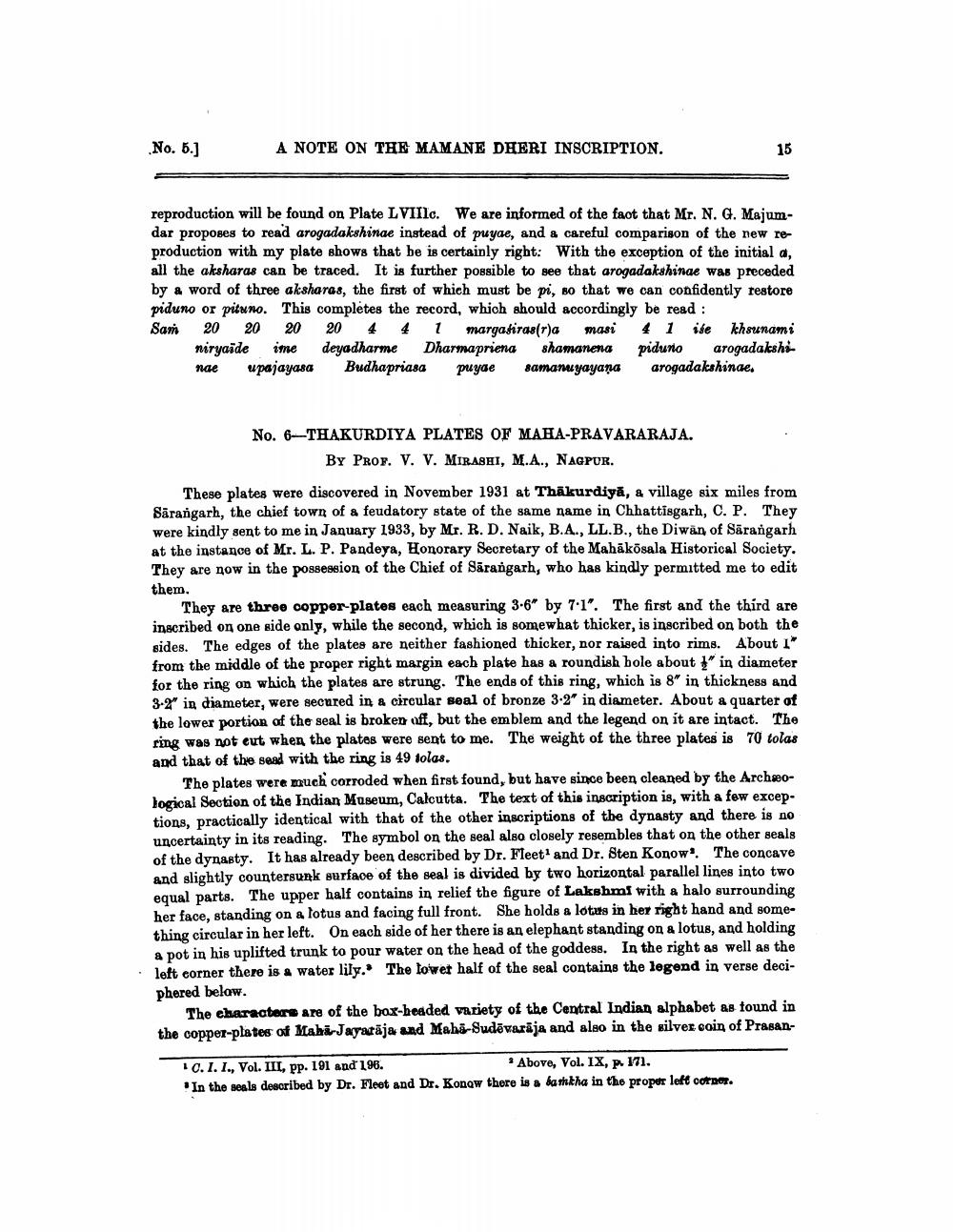________________
No. 6.]
A NOTE ON THE MAMANE DHERI INSCRIPTION.
reproduction will be found on Plate LVIII. We are informed of the fact that Mr. N. G. Majumdar proposes to read arogadakshinae instead of puyae, and a careful comparison of the new reproduction with my plate shows that be is certainly right: With the exception of the initial a, all the aksharas can be traced. It is further possible to see that arogadakshinae was preceded by a word of three aksharas, the first of which must be pi, so that we can confidently restore piduno or pituno. This completes the record, which should accordingly be read : Sam 20 20 20 20 4 4 1 marqafiras(r)a masi 4 1 ise khsunami
niryaide ime deyadharme Dharmapriena shamanena pidurio arogadakshi nae upajayasa Budhapriasa puyde samanuyayana arogadakshinae.
No. 6-THAKURDIYA PLATES OF MAHA-PRAVARARAJA.
BY PROF. V. V. MIRASHI, M.A., NAGPUR.
These plates were discovered in November 1931 at Thakurdiya, a village six miles from Sārangarh, the chief town of a feudatory state of the same name in Chhattisgarh, C. P. They were kindly sent to me in January 1933, by Mr. R. D. Naik, B.A., LL.B., the Diwan of Särangarh at the instance of Mr. L. P. Pandeya, Honorary Secretary of the Mahākösala Historical Society. They are now in the possession of the Chief of Sārangarh, who has kindly permitted me to edit them.
They are three oopper-plates each measuring 3-6" by 7.1". The first and the third are inscribed on one side only, while the second, which is somewhat thicker, is inscribed on both the sides. The edges of the plates are neither fashioned thicker, nor raised into rims. About I" from the middle of the proper right margin each plate has a roundish bole about " in diameter for the ring on which the plates are strung. The ends of this ring, which is 8" in thickness and 3-2" in diameter, were secured in & circular Beal of bronze 3-2' in diameter. About a quarter of the lower portion of the seal is broken off, but the emblem and the legend on it are intact. The ring was not eut when the plates were sent to me. The weight of the three plates is 70 tolas and that of the sead with the ring is 49 tolas.
The plates were much corroded when first found, but have since been cleaned by the Archeological Section of the Indian Museum, Calcutta. The text of this inscription is, with a few exceptions, practically identical with that of the other inscriptions of the dynasty and there is no uncertainty in its reading. The symbol on the seal also closely resembles that on the other seals of the dynasty. It has already been described by Dr. Fleet and Dr. Sten Konow! The concave and slightly countersunk surface of the seal is divided by two horizontal parallel lines into two equal parts. The upper half contains in relief the figure of Lakshmi with a halo surrounding her face, standing on & lotus and facing full front. She holds a lotus in her right hand and something circular in her left. On each side of her there is an elephant standing on a lotus, and holding a pot in his uplifted trunk to pour water on the head of the goddess. In the right as well as the left corner there is a water lily. The towet half of the seal contains the legend in verse deciphered below.
The characters are of the box-hoaded variety of the Central Indian alphabet as found in the copper-plates of Mahi Jayatäja and Maha-Sudēvarāja and also in the silver coin of Prasan
10.1. I., Vol. III, pp. 191 and 196.
*Above, Vol. IX, p. 171. ! In the seals described by Dr. Fleet and Dr. Konow there is a baththa in the proper left ootpor.




